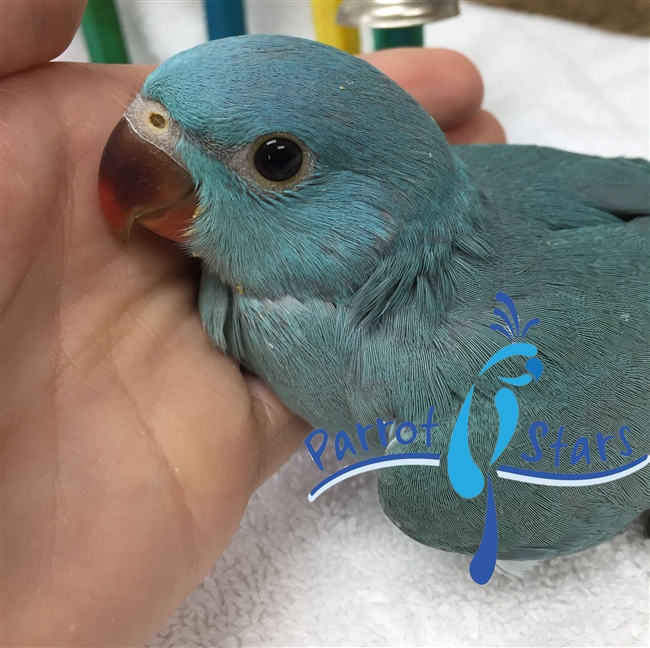Feeding baby canary
What Do Baby Canary Birds Eat? 6 Food Supplements
Baby canary birds eat nesting food which may differ from seeds to green supplies. Baby canary birds can also digest the seeds supplied by their parents. However, for healthy and active canary babies, nesting food along with green food supplements is necessary.
There are also readymade food/ seed supplements for the baby canary birds available in the market which need to be mixed either with water or sometimes with milk to be provided to chicks.
But, the best practice that I have ever experienced while feeding my canary baby birds is easy and affordable to everyone. Such supplements of foods have never disappointed me and will not disappoint you as well.
There are the following food supplements that baby canary birds eat.
1. Egg
2. Cucumber
3. Lettuce Salad
4. Hemp Seeds
5. Seeds
6. Nesting food
What Do Baby Canary Birds Eat1. Eggs
While feeding the baby canary birds when they hatch from the first day, I put a boiled egg in the container for their parents which they start to carry for their chicks. Egg contains vitamins and other necessary nutrients that nourish the baby canary chicks at an earlier stage very well.
The egg supplement should always be replaced each day with the fresh one to serve healthy food supplements to canary bird babies.
After the canary chicks reach 3 weeks or a month, a meshed boiled egg may be served. After a month they start sitting on perches and fly here and there. So, they do also try to taste the supplements. A meshed egg is the best supplement and beginner food for these birds to learn to eat. A meshed egg can be continued for 7 to 10 days more unless they can easily break the shells of the seeds to eat.
2.
 Cucumber
CucumberThe next food supplement that is very essential for the baby canary birds to eat is the cucumber. Cucumber supplies all liquid and digestion nutrients to canary bird babies which also protects them from constipation and other stomach issues.
In addition, each time when you serve egg to canaries it is also very necessary to supply cucumber or salad after the egg supplements. Because in most cases, canary birds can easily get sick and confront diseases like diarrhea especially in summer and hot seasons.
Cucumber can be continued from day 1 to day 60 for the baby canary birds. It doesn’t have any side effects for canary birds. Even it improves the shininess of feathers of canary baby birds.
I have also experienced that cucumber can be a healthy supplement while in molting season for canary birds.
Read more about Canary Birds Foods Here
Well, when baby canary birds leave their nest and start to fly and jump.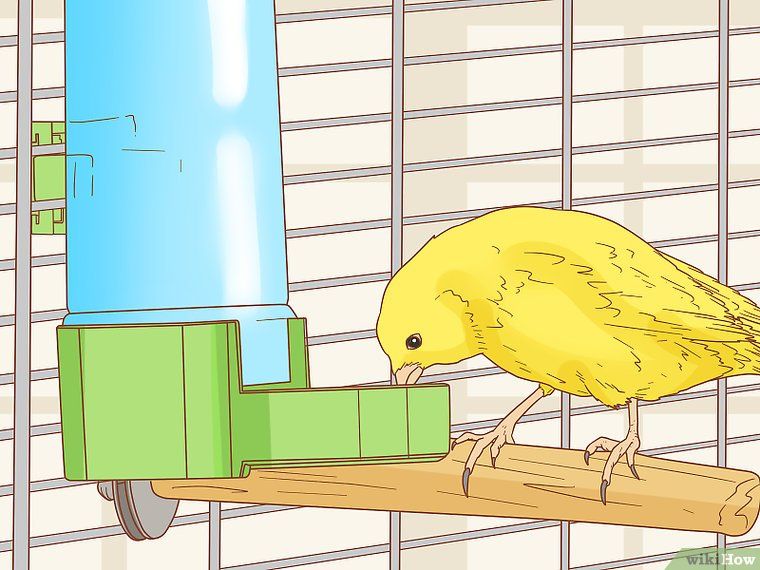 Cucumber cut into half and placed in a container or on perch, chicks start to taste it and learn eating easily. It can also fulfill the need for water to be maintained in their body until they learn to drink from the water tank.
Cucumber cut into half and placed in a container or on perch, chicks start to taste it and learn eating easily. It can also fulfill the need for water to be maintained in their body until they learn to drink from the water tank.
So, I find and suggest cucumber an essential food supplement for the baby canary birds to eat on regular basis.
3. Lettuce Salad
Lettuce is also a good food supplement for baby canary birds to eat. It can be served as like egg and cucumber on daily basis from hatching up to 60 days after the hatching.
This is also a great source of energy for canaries while digesting their food. But, you need to be more careful while serving salad to canaries either baby canary birds or adults.
Before, serving salads you need to taste it if it tastes good. In case, the taste is different and bittering, don’t supply it to the birds. You may lose your bird.
4. Hemp Seeds
Hemp seeds are also an essential food supplement for baby canary birds to eat. Hemp seeds may be kept in the water for more than an hour or should be boiled for about half-hour and then be kept to dry.
Hemp seeds may be kept in the water for more than an hour or should be boiled for about half-hour and then be kept to dry.
Once they are dried and the shells of the seeds are open, you can serve these to canary chicks. This supplement can also be served from day 1 to day 50.
Hemp seeds contain all necessary nutrients that help baby canary birds to nourish in the body. They get a healthy and fit body through this food supplement.
Once they step out of the nest and start learning to eat eggs, cucumber, and salad, the hemp seed is the first and easy step for learning to eat seeds. Because their shell is already open and easy to break so they find it very comfortable and easy.
Note: This supplement should be stopped after 45 to 50 days depending on the body and size of chicks because the continuous supplement would cause fatness and heaviness. However, it can be served on a weekly or monthly basis.
5. Mixed Seeds
Normally mixed seeds are served to baby canary birds by their parents from hatching until they learn to eat.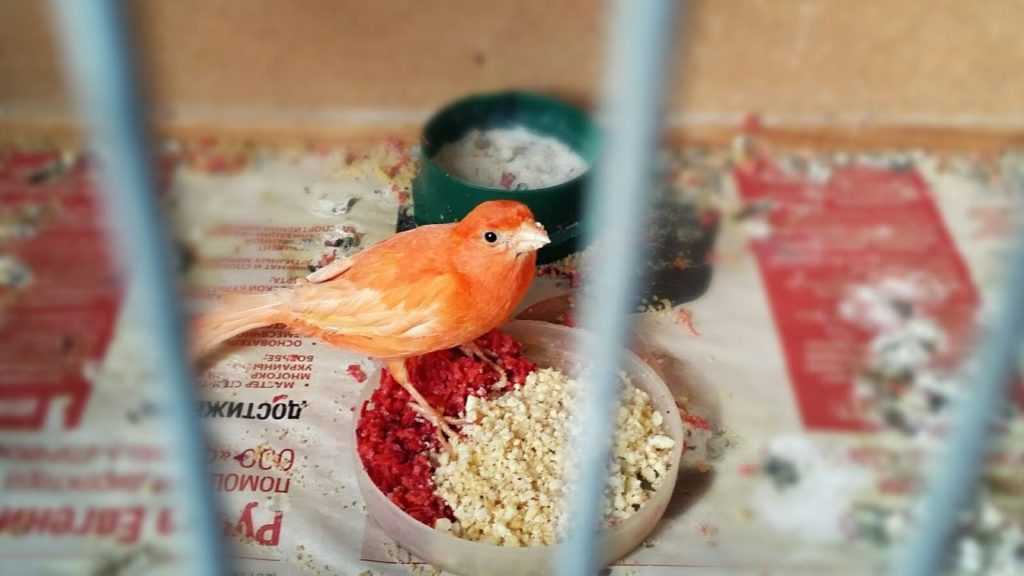 However, male and female canary birds love to serve soft food supplements to chicks as that is easy to digest.
However, male and female canary birds love to serve soft food supplements to chicks as that is easy to digest.
Mixed seeds are an essential part of the food supplements for baby canary birds as they will be part of their diet in the future.
But, from day 1 to day 30 to 40, baby canary birds find it hard to eat seeds. However, they do practice and continue to learn to eat mixed seeds.
6. Nesting Food
Nesting food means the ready-made available food supplements for the baby canary birds. These supplements contain all necessary nutrients in one place where you don’t need to supply various food supplements.
You can say that it is all in one package for the baby canary bird’s diet. It is the best option for those canary birds lover who doesn’t have much time and can’t do much hard work to put each supplement separately.
My thoughts:As I have already shared all my experience with you people.
I would love to go for naturally available food supplements for my baby canary birds to eat as they are fresh and I have always been applying these methods which never disappointed me availing clutches of canaries.
I hope you have now an easy and affordable natural way of food supplements for your baby canary birds that they can eat and grow well naturally.
Let me know if you have any question and reach me out. I would love to help you.
What To Feed Newly Hatched Canaries [A Complete Guide]
(Last Updated On: October 26, 2022)
Baby canaries usually hatch 13-14 days after being laid, emerging hungry for food. Newly-hatched canaries have sensitive digestive systems. So, if you have fledglings, they need to be fed the right diet.
Baby canaries should subsist on a diet of nutrient-rich nestling food consisting of softened seeds, hard-boiled eggs (or egg food), crushed fruits, and vegetables.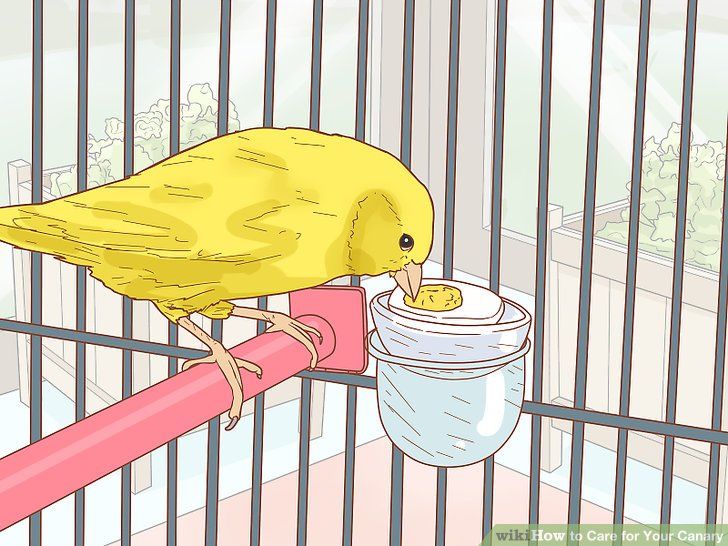 Once you start weaning baby canaries, continue feeding them nestling food until they’re ready to start eating seed mixes.
Once you start weaning baby canaries, continue feeding them nestling food until they’re ready to start eating seed mixes.
Offering nestling food to your canaries supplies your baby canaries with the nutrients they require to grow healthy and replenishes the energy of the nursing parents.
What To Feed Canary Babies
Provide nestling food to your canaries on the 12th day of incubation. Nestling food is the food that a nursing female eats before feeding it to her hatchlings once they emerge from the eggs.
According to Biological Sciences, parent canaries are attuned to posturing behavior and calling by their chicks, which signals the time for feeding.
Once the fledgling canaries are ready to leave the nest, they’ll continue feeding on nestling food on their own. Eventually, they’ll transition to the normal seed mixes that adult canaries eat.
Nestling food should be nutrient-rich with a high protein content to ensure nursing parents receive enough nutrition to keep their energy levels high before the baby canaries hatch. Afterward, the same seed and supplement mix will aid the growth and development of canary chicks.
Afterward, the same seed and supplement mix will aid the growth and development of canary chicks.
Here are the most important ingredients in canary nestling food:
Soft Seed
Canaries mainly eat a seed-based diet that consists of the following:
- Millet
- Hulled oats
- Rapeseed
- Flaxseed
- Perilla
While adult canaries can eat dry seed mixes easily, the digestive system of baby canaries is too fragile and underdeveloped to break down the hard shells of seeds. So, give them soft seeds.
There are several ways to soften seed mixes to make them more palatable and easy to digest.
You can boil the normal seed mix for 20 minutes and allow it to cool before offering it to your canaries. The parents will use this soft seed mix to feed their fledglings for the next 2 weeks as they go through their formative stages of growth.
You can soften the canary seed mix by soaking it in water. There are soaked seed mixes that you can get from a pet store and soak them using the directives prescribed on the packaging.
To prepare the seed mix for your baby canaries, do the following:
- Soak the seed mix at room temperature for 2-3 days to encourage sprouting.
- Strain the water.
- Check the seeds to ensure there’s no sign of mold growth.
- Rinse thoroughly before adding it to your nursing canaries’ food.
Boiled Egg or Egg Food
Fledglings require a high-protein diet to grow and develop healthily.
According to Comparative Biochemistry and Physiology, newly-hatched canaries undergo a rapid growth rate in the first 2 weeks after hatching, achieving 90% of their asymptomatic body mass by day 11.
Since eggs are a rich source of protein, include eggs in your canaries’ nestling food at least 12 days before they hatch.
Eggs also contain high amounts of calcium, which is crucial for the growth and development of bones, beaks, and feathers. Most of the calcium content is concentrated in the eggshells, so include crushed pieces of eggshells (put through a blender) in your canary’s nestling food.
The most common way to offer eggs to canaries is in the form of hard-boiled eggs. So, boil an egg for 10-15 minutes and let it cool before offering some to your baby canaries.
Alternatively, you can provide egg food. This is a crumb-like food mix containing eggs, bird seeds, and assorted vegetables.
Vegetables And Fruits
Baby canaries have weaker immune systems than fully-developed adult canaries. For this reason, it’s important to include immune-boosting foods in your nestling birds’ diet.
Leafy green vegetables and fruits are rich in vitamins and minerals, which support the immune system of adult canaries while feeding their fledglings.
Most fruits and vegetables can be fed to baby canaries, including:
- Apples
- Bananas
- Apricots
- Spinach
- Melon
- Broccoli
- Dandelion
- Grated carrots
- Tomatoes
- Kales
- Bok choy
- Collard greens
- Pineapple
Chop the vegetables into bite-sized pieces to make them easier for baby canaries to swallow.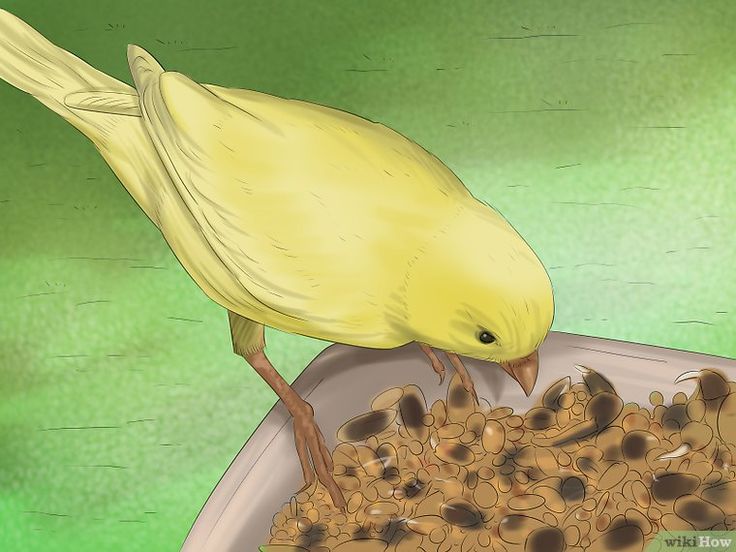
When Can I Feed A Baby Canary?
Only hand-feed baby canaries once they’re fully weaned and ready to leave the nest.
This is usually when they’re about 4 weeks old. Fledglings less than 3-4 weeks old are directly fed by their parents from the nestling food you provide.
Once baby canaries are old enough to leave the nest (about 2-3 weeks after hatching), they’ll continue to feed on the nestling food before transitioning to the seed mix diet that adult canaries typically eat.
At this point, you can start hand-feeding them and begin introducing more variety to their diet.
How Often Should You Feed Baby Canaries?
The recommended frequency of feeding for baby canaries varies depending on the stage of development that they’re currently in. If a baby canary hasn’t opened its eyes yet, it needs to be fed at least 5-6 times per day, with 3-4 hours intervals.
Once the fledglings’ eyes are open, you can feed them 3-5 times (once every 5 hours). When their feathers begin to emerge, you can feed them 3 times per day.
How Long Can A Baby Canary Survive Without Food?
As fragile and helpless as baby canaries are, they can survive without food or water for up to 24 hours.
However, this is unlikely to happen if the canary’s parents are around since the parents will feed their young each time they have access to food.
However, if both the parents of the fledglings are deceased, feed the orphaned birds yourself.
Hand Feed Baby Canaries
Although it won’t be possible to hand-feed newborn canaries all the time, it does have advantages.
For instance, hand-reared hatchlings make better pets in the long term because humans have socialized them. So, hand-fed newborn canaries are less fearful of humans.
Hand-feeding fledglings is a significant responsibility, requiring patience, commitment, and time. If you need to hand-feed a baby canary, there are guidelines you must observe:
Freshness
Ensure the food mix is fresh and safe for consumption. So, avoid feeding them leftover foods since they may harbor bacteria or yeast, which can be harmful to canaries.
Hot And Cold Spots
Mix it thoroughly to ensure a uniform temperature if you’re preparing food in a microwave.
Ideally, the temperature throughout the food mixture should be about 102-106 degrees Fahrenheit. If the food is hotter, it can cause burns to a canary’s crop.
If the food is too cold, a canary may digest it more slowly or reject it entirely.
Dilute Food
Day-old chicks should be fed a 90% diluted mixture as they still utilize the egg’s yolk sac. However, fledglings more than 1-2 days old should be fed a food mixture that’s 70-75 % liquid.
Right Tools
Syringes are preferred feeding tools for baby canaries since they allow more accurate recording volumes. However, if you don’t have a syringe, use a small spoon with its sides bent up and inward.
Keeping track of daily feeding is important to ensure you don’t overfeed your fledglings.
Proper Feeding
You can tell whether your canary is feeding properly if it rapidly bobs its head up and down.
This natural feeding response causes the trachea to close, making it possible for a canary to quickly swallow large amounts of food.
If your canary isn’t exhibiting this response during feeding, refrain from feeding it since this can cause food aspiration into the trachea and lungs, which can cause sudden death.
So, when hand-feeding your baby canaries, always feel their crops (the sac hanging at the base of the neck) to check whether they need feeding. Only administer food if the crop feels empty.
How to feed a canary with chicks, how to care for them?
It is very important to know how to feed a canary with chicks, because the health of the female and babies depends on it.
The female usually starts feeding the chicks regularly the next day after they are born , but good females start feeding the chicks after 2-3 hours.
If the canary feeds the chicks well, they lie calmly in the nest, in a dense lump against each other, with their heads tucked down, food peeps through the walls of the goiters, the chicks grow rapidly. The abdomen of such a chick is swollen, tight, the skin on the abdomen is smooth, without folds and wrinkles. nine0003
The abdomen of such a chick is swollen, tight, the skin on the abdomen is smooth, without folds and wrinkles. nine0003
When the female begins to hatch, she should be fed only grain (see "What can I feed a canary?"), Without additional ration. Excessive feeding of the mother hen leads to the fact that she will incubate the eggs poorly, often fly off them, and, perhaps, after a while, she will prematurely call the male again and build a new nest, destroying the old one.
Only a day before the chicks hatch, canaries additionally include a small amount (1/2 teaspoon) of chopped chicken egg with grated cracker in the feed ration. nine0003
What to feed a canary with chicks? From the moment the chicks appear, the female is regularly given egg food, one teaspoon per day, gradually increasing this portion to 2-3 tablespoons per day, since as the chicks grow, the canary intensifies their feeding. On warm summer days, egg feed should be given in smaller doses, but several times a day, to avoid spoilage.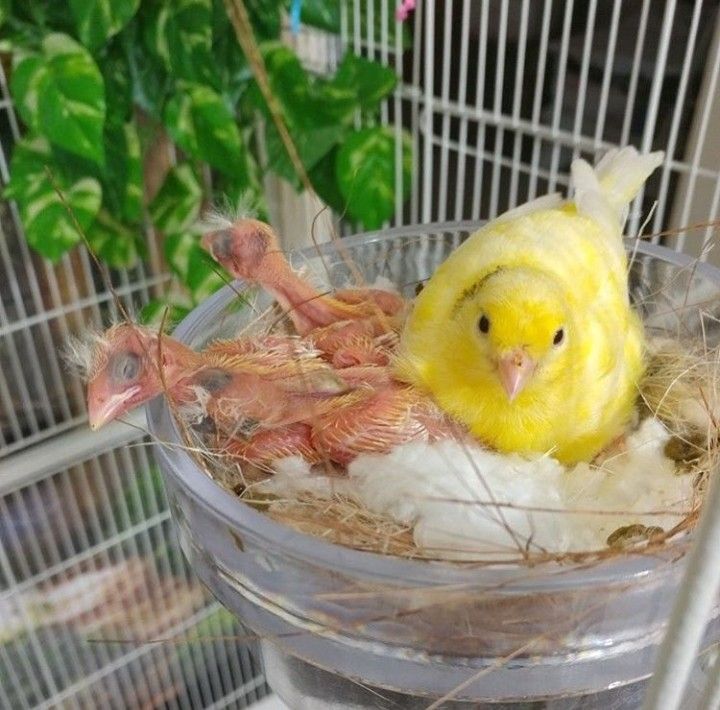
On the 5th day after the birth of the chicks, you can start giving the female an additional slice of fresh carrots or a slice of sweet apple , fixing them between the bars of the cage near the perch. Crushed multivitamins in the form of dragees can be added to egg feed. Greens should not be given to a nursing female. Bathing suits should be suspended from the cage from the moment the male and female are put into it and until the end of incubation. Then a break is made and after the chicks reach 8-10 days of age, the bathing of the female must be resumed. This break is necessary, because otherwise the female may catch a cold of the chicks, which are extremely weak until this time. Bathing while incubating helps keep the female's plumage and egg shells clean. All this contributes to the development of the embryo in the egg, as it creates an influx of moist air in the nest and increases the exchange of oxygen in the egg through the clean pores of the shell. With systematic bathing during incubation, there are almost no cases of death of the embryo in the egg. nine0003
nine0003
At the age of 5 to 7 days, the eyes of the chicks open , more intensive growth of plumage and faster development begin. On the 7-8th day, the chicks are banded (see "Accounting and banding of canaries"). Due to the fact that by this time the female cannot cope with cleaning the nest (removing the litter), it is recommended to clean or change the nest at the same time, for which, after shifting the chicks carefully to another nest, change the old bedding of thread and remove dirt, and then put the chicks back in . nine0003
On the 18-20th day the chicks start to fly out of the nest . It is not necessary to speed up the departure of the chicks from the nest, the more they stay like this, the better it will affect their development. After leaving the nest, the chicks should be left in the cage with the female until they begin to peck food on their own (this occurs on the 23-24th day). Then, after waiting another 2-3 days and making sure that all the chicks eat food on their own, at first only egg, and then grain (scalded and dried rapeseed), they are transferred to a separate cage and, after allowing them to fly around for several days, are then transferred to a large span cell. Chicks should be planted at 26-28 days of age. Sometimes, a week before the chicks are deposited, some females, showing a desire for nesting, begin to pluck the chicks. So that the chicks do not die, they need to be transferred to another female, and if this is not possible, they should be deposited in a small cell, placing it close to the cage. The female will feed the chicks through the bars of the cage. Of course, the quality of feeding will deteriorate significantly. nine0003
Chicks should be planted at 26-28 days of age. Sometimes, a week before the chicks are deposited, some females, showing a desire for nesting, begin to pluck the chicks. So that the chicks do not die, they need to be transferred to another female, and if this is not possible, they should be deposited in a small cell, placing it close to the cage. The female will feed the chicks through the bars of the cage. Of course, the quality of feeding will deteriorate significantly. nine0003
_______
From the book by Iosif Abramovich Rozin “Canary. Care, maintenance and breeding, 1959
Here you can read How to feed canary chicks? Sex determination of canaries
singing, breeding, care and maintenance, photo
Canaries are one of the most musical and undemanding domestic birds.
For more than one century, canaries have delighted their owners with pleasant melodic singing, a variety of colors and unusual shapes.
The body length of the indoor canary is 12x14 cm. The wild species is somewhat smaller than the domestic form (12–13 cm long) and differs greatly from it in color. The male is green on top with black longitudinal lines, the upper part of the head, throat and rump are yellow-green, the color of the chest turns yellow posteriorly, the belly is white. The color of the female is paler due to the grayish edges of the feathers, her back is brown-gray with black lines. Captivity has greatly changed the canary, and its color has become a solid yellow. A mixture of a wild canary with a domestic one is very beautiful, it is colored with a mixture of green and yellow. nine0003
The wild species is somewhat smaller than the domestic form (12–13 cm long) and differs greatly from it in color. The male is green on top with black longitudinal lines, the upper part of the head, throat and rump are yellow-green, the color of the chest turns yellow posteriorly, the belly is white. The color of the female is paler due to the grayish edges of the feathers, her back is brown-gray with black lines. Captivity has greatly changed the canary, and its color has become a solid yellow. A mixture of a wild canary with a domestic one is very beautiful, it is colored with a mixture of green and yellow. nine0003
And it is not surprising that all over the world canaries enjoy great and, of course, well-deserved popularity, which is constantly growing.
According to information that has come down to us, already in the 14th century, Spanish and Portuguese sailors began to gradually bring the singers who had so charmed them back to their homeland. Most likely, these were canaries already accustomed to captivity, bought from local residents, who were happy to keep little singers at home, in cages woven from twigs. Thus began the proud "march" through the world of discreet, but so generously endowed by Nature island birds. nine0003
Thus began the proud "march" through the world of discreet, but so generously endowed by Nature island birds. nine0003
Keeping canaries
The canary is easily tamed, quite trusting, amenable to "education" and successfully breeds at home. Canaries can live at home for 15-18 years, they are kept in cages and aviaries.
The size of the cage is 30-35 cm long, 20-22 cm wide, 27-29 cm high. The distance between the twigs is no more than 1.2-1.4 cm. The door in the cage should be located on the side. The bottom must be double, preferably made of thin stainless steel (inner bottom) and always retractable, so that it is easier to clean the cage, change the sand in it and disinfect. nine0003
Feeders can be placed on the bottom of the cage, but this most often results in an unsanitary condition of the feed and the cage. It is desirable, however, that the feeders in the cages be retractable. In this position, it is easy to get them when feeding and the birds will have less anxiety.
The cage must have a perch for a bird, which is a round perch with a thickness of not more than 1.5 cm. The surface of the perch is left rough, not cleaned. The distance between the perches should be such that, jumping from one to the other, the bird can freely flap its wings. nine0003
Canaries love to swim. Bathing cleanses the skin and strengthens the plumage. Bathing water should be at room temperature. The bathing suit is attached to the outside of the door so that water does not get into the cage. After each bath, the bathing suit is cleaned and the doors are closed. Bathing suits should be washed daily. Canaries should be taught to bathe from an early age, that is, from the moment they are jigged from the female - after 30-35 days of age.
Cages should be cleaned at least twice a week. At this time, the bird needs to be transplanted - overtaken to another cage, placing the cages with open doors to each other. The entire inventory of the cage - a pallet, feeders, drinkers, perches - must be taken out and rinsed well with hot water.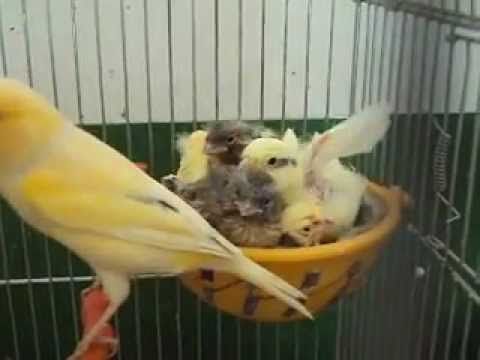 nine0003
nine0003
Drinking water must be at room temperature. It is poured into small glass or porcelain dishes (3-4 cm high) and placed on the bottom of the cage in a place convenient for drinking birds. Between the twigs of the cage, you can insert small feeders in the form of a thimble or a plastic cork for periodic feeding with honey, grated carrots, yolk in addition to the main food.
Place the cage in a well-lit place, but not in the sun, not in a window, and not in a draft. If the room closes, you can and should let the bird fly. Initially 5-10 minutes, and then up to 40-45 minutes. You can teach a bird to sit on your hand, on your shoulder, but this requires a lot of patience. Cages with canaries should be approached so that the birds can see you: talking to them in an even, gentle voice will win the bird's trust. nine0003
Feeding canaries
Feeding canaries is not difficult. The main feed is grain mixture.
In order for the canaries to eat all the food offered to them, and not to choose especially favorite components and not to get fat at the same time, it is necessary to strictly observe its daily allowance.
On average, 1-1.5 teaspoons with a hill of grain mixture are relied on per bird daily. This norm may vary somewhat depending on the breed and the physiological state of the birds. nine0003
So, during the molting period, the norm should be increased, since the phenomenon of hyperphagia occurs in birds, that is, a large consumption of food necessary for the formation of a new plumage. At this time, obesity cannot occur.
It should also be remembered that the bioenergy metabolism of small birds is very high, so they should not be left without food in the daytime, even for 1-2 hours.
In addition to grain, canaries need soft and green food.
One portion of soft food is prepared from half a boiled egg yolk, grated, with the addition of one teaspoon of ground crackers, semolina or, better, baby food (such as “baby” porridge) and a pinch of poppy seeds. nine0003
Various vegetables and fruits are a good source of vitamins and carotene. They are cut into slices and strengthened between the bars of the cage near the perch.
From green food canaries should be given: carrots, bell peppers, cabbage, lettuce, spinach, celery and dandelion leaves, parsley, apples, pears and strawberries. Like other birds, canaries need mineral feed. They should always be in a separate feeder. These include crushed eggshells, chalk, charcoal, coarse sand or shell rock. nine0003
Non-carbonated mineral water can be used as an addition to mineral supplements.
Birds should be accustomed to new foods gradually. An abrupt change can cause intestinal upset in birds, forced untimely molting and other diseases, so when buying birds, ask what the previous owners fed them.
Crushed nuts and sunflower seeds should also be added to the bird menu.
Breeding of canaries
In their homeland, in natural conditions, the breeding season of wild canaries begins in the 2nd half of March. The best time for mating and breeding chicks in our conditions is spring (March, April, May). During this period, there is a longer daylight hours, and the female can feed the chicks longer. To obtain good offspring, it is necessary to carefully select the male and female. The male should be large, with an interesting song, beautiful plumage, active. Age - at least 1 year old. The female must also have the appropriate qualities. It is advisable to pair males from one and a half to two years and even up to five years, and females - from 11 months to three to four years. The coloration of the offspring is influenced by both producers, and the male influences the vocal qualities, susceptibility to the song and hearing. This should also be taken into account when choosing a pair. nine0003
To obtain good offspring, it is necessary to carefully select the male and female. The male should be large, with an interesting song, beautiful plumage, active. Age - at least 1 year old. The female must also have the appropriate qualities. It is advisable to pair males from one and a half to two years and even up to five years, and females - from 11 months to three to four years. The coloration of the offspring is influenced by both producers, and the male influences the vocal qualities, susceptibility to the song and hearing. This should also be taken into account when choosing a pair. nine0003
Some fanciers practice breeding one male with two or three females and still get normal broods, but this requires a lot of experience. A more accessible way is to bring one male to one female. Before mating, a cage with a male and a cage with a female are placed side by side so that the birds can see each other and begin to show mutual interest. The male during this period daily, for 5-6 days, is given soft food in addition to grain. Increase the diet and females. Ready for mating birds are planted in one cage. The male is planted first, and after a day or two, the female is planted next to him. The female released to the male quickly mates with him and proceeds to build a nest. From the start of mating and nest building to the laying of the first egg, it takes from three to ten days. nine0003
Increase the diet and females. Ready for mating birds are planted in one cage. The male is planted first, and after a day or two, the female is planted next to him. The female released to the male quickly mates with him and proceeds to build a nest. From the start of mating and nest building to the laying of the first egg, it takes from three to ten days. nine0003
Mating cage may be standard or slightly larger. The nest can be hung in the corner of the cage from the inside or outside, in a quiet place.
In order for the female to build a nest in peace, she needs to put into the cage pieces of cut cotton or linen threads 2-3 cm in size, small pieces of linen or cotton fabric and even well-dried small hay collected in a ball. Within 6-7 days, the female builds a nest, after which she begins to lay eggs. After the female lays 3-4 eggs, the male is removed from the cage, as the female herself can feed the chicks. But you can leave the male, and he will actively help the female in hatching and feeding the chicks.





